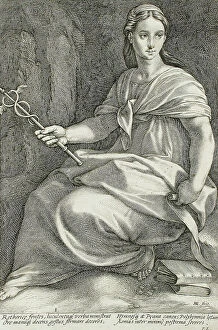Polyhymnia Collection
"Polyhymnia: The Muse of Lyrical Poetry and Music" Step into the world of ancient art and mythology as we explore the captivating figure of Polyhymnia
All Professionally Made to Order for Quick Shipping
"Polyhymnia: The Muse of Lyrical Poetry and Music" Step into the world of ancient art and mythology as we explore the captivating figure of Polyhymnia, one of the nine Greek muses. This Roman mosaic from the 3rd-4th century AD, found in Torre de Palm, depicts a stunning portrayal of these inspirational goddesses. In this enchanting mosaic, Polyhymnia stands alongside her fellow muses Calliope and Urania. Their graceful forms exude elegance and creativity, reminding us of their role as patrons of literature, science, and the arts. Another depiction by an anonymous artist showcases Polyhymnia herself during the Renaissance period. Created between 1540-1545, this artwork captures her divine beauty with intricate details that highlight her significance in inspiring poets and musicians throughout history. The influence extends beyond visual arts; she is also celebrated in sculpture. In "The Apotheosis of Homer, " sculpted by Archelaus of Priene, we witness a breathtaking bas-relief where she pays homage to the legendary poet himself. Her presence emphasizes how poetry intertwines with music to create masterpieces that transcend time. Hermann von Kaulbach's rendition further immortalizes Polyhymnia's essence through his statue depicting her serene countenance. As viewers gaze upon this masterpiece created between 1846-1909, they can almost hear melodies flowing from her lips – a testament to her connection with Euterpe, muse of music. Ancient Rome recognized Polinnia or Angerona as their own version - a goddess associated with silence and secrecy. A majestic statue dedicated to either deity reminds us that inspiration takes many forms across different cultures. Chromolithographs bring forth vibrant colors when portraying both Euterpe's musical prowess and Polyhymnia's lyrical poetry side by side.






































